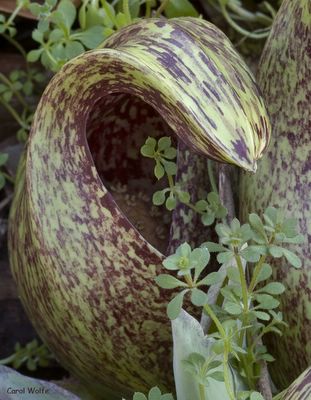
Bloodroot leaf, March 30, 2006. Still wrapped loosely around the stem, this leaf is in the very early stages of development, less than one inch long. When full grown, it could be 4 to 6 inches long and across. I love the way this image shows the texture and shape of the edges of these really cool leaves. This image is lit by sunlight, from the left, with a diffuser. I used a very thin diffuser, actually a pop-up "laundry basket" rather than the regular more thick diffuser that I usually carry in my backpack.
I rescued this plant two days ago along with several others from a steep, rocky hillisde that is currently buried under 10 feet of dirt (and packed down by bulldozers)--in preparation for the construction of an on-ramp not far from my house. I got out there Tuesday evening, about 28 hours after they first closed the old road. It had rained most of the day on Tuesday, so the big yellow machines did not start their job of ripping into the hillside. I parked in a parking lot not far from the "sacred" location where bloodroots had bloomed last year. And I went out with small shovel and hand rake. I dug up four big clumps of bloodroot, in the midst of broken beer bottles and all kind of other trash. I was happy to be liberating these beautiful flowers from this ugly hillside home. As far as I know, I found and saved them all. Timing was perfect: The bloodroot was just barely beginning to emerge from the dirt--none was in bloom yet, and most were just little spikes sticking out of the dirt. Even one week sooner, and I would have been unable to find these special plants in midsts of all the "weeds" and "grass" and trash.
Within 12 hours after my rescue mission was complete, the destruction had begun. By the time I drove by the next morning, the road had already been crumbled into gravel. By that afternoon, the bulldozers had already started scraping one hillside and filling in the area where the road was, and filling over and packing the dirt on top of the hillside where these wonderful flowers had been living. I saved them in the nick of time. And today they rewarded me with many flowers in bloom...





















